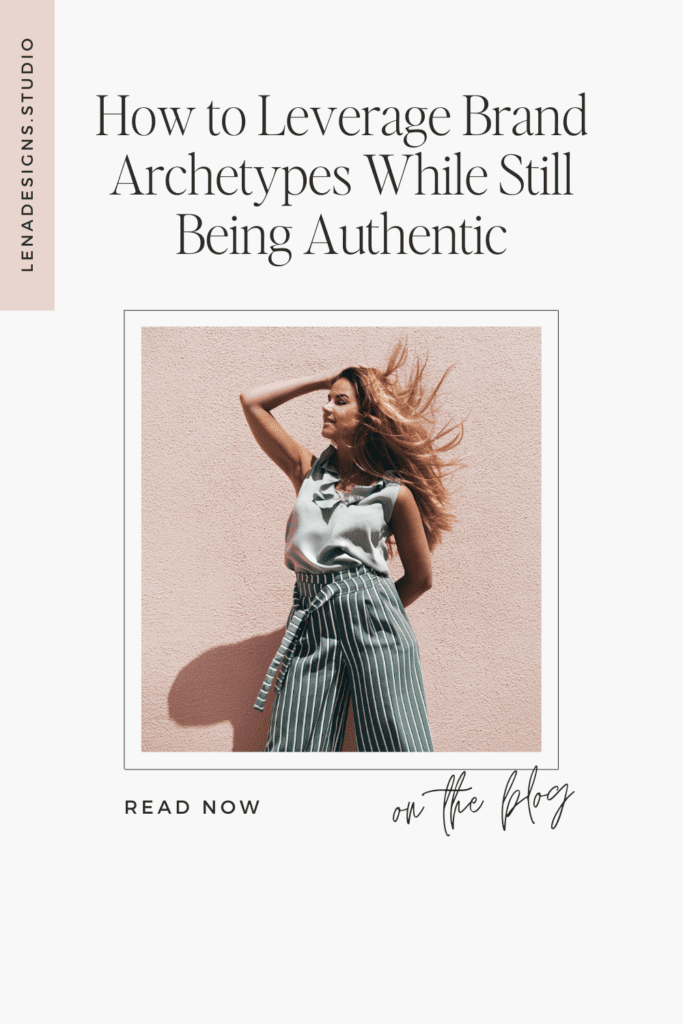Are You Letting Your Brand Archetype Box You In?
Brand archetypes are a powerful tool for shaping how your business communicates. They help clarify your voice, deepen your emotional connection, and give your brand a recognizable presence.
But here’s where it gets tricky: too many entrepreneurs treat their archetype like a rigid identity they have to perform instead of a flexible lens through which they can create.
You may have worked with a brand strategist, defined your archetype, and committed to bringing it to life. But over time, your brand started to feel disconnected, as if you were playing a role rather than speaking from your truth. Your voice doesn’t sound like you anymore. Your messaging isn’t landing. Instead of attracting aligned clients, you’re attracting confusion.
That’s not a failure on your part; it’s a misunderstanding of how archetypes are meant to function.
They’re not a costume. They’re a current you can tap into, one that strengthens your message without diluting who you are.
So if you’re feeling boxed in, here’s how to break out without abandoning the archetype entirely.

When Your Archetype Becomes a Cage Instead of a Catalyst
Used thoughtfully, brand archetypes add clarity and emotional depth to your brand strategy. But used rigidly, they can flatten your brand into something predictable and performative. Here’s how that shows up:
1. You Start Sounding Generic
Most archetypes come with stereotypical language and themes. If you’re not careful, you end up parroting what others in your category are already saying.
Why this is a problem: It strips away the qualities that make your brand distinctly yours. The archetype becomes the voice, instead of supporting it.
Example: A Sage brand relying too heavily on academic language and “teaching moments” might come across as cold or distant, even if the person behind the brand is deeply warm and engaging.
2. Your Voice Feels Forced
You try to fit every piece of content into your archetype’s mold. It’s like writing a script you’re expected to follow, even when it doesn’t feel natural.
Why this is a problem: Consistency is valuable, but not when it sacrifices connection. If you’re constantly editing yourself to stay “on brand,” the message will lose authenticity, and your audience will feel it.
Example: A Creator brand that defaults to flowery, abstract language when their natural communication style is bold and clear. The disconnect makes the message harder to follow and less impactful.
3. Your Messaging Becomes Scripted
Archetypes are meant to inspire tone and emotion, not dictate your every word. But some brands become overly cautious, afraid to step outside the lines.
Why this is a problem: People can sense when your messaging feels overly polished or generic. It stops sounding like a conversation and starts sounding like a performance.
Example: A Hero brand locked into constant motivational speak can lose credibility if there’s no vulnerability or real-world insight to back it up.
4. You Lose Emotional Resonance
When archetypes become the main character in your brand story, your personal experiences and perspective often take a back seat.
Why this is a problem: Connection isn’t built on archetypes; it’s built on trust. And trust requires truth, nuance, and a willingness to be seen.
Example: A Jester brand that focuses so much on being entertaining, they never reveal the mission or values driving the business. People laugh, but they don’t remember why they should care.
What to Do Instead: Use Your Archetype as a Guide, Not a Script
Your archetype shouldn’t be the star of the show. It should be part of the creative direction, like a stylist helping you choose what to wear on stage, not the person giving the speech for you.
Here’s how to work with your archetype in a way that enhances your authenticity, rather than muting it.
1. Reconnect With Why You Chose It in the First Place
Instead of asking “What does a Ruler brand do?”, ask “What about this archetype felt aligned with how I already operate?”
This keeps your brand grounded in truth. It’s not about matching a definition; it’s about amplifying traits you already embody.
Implementation Tip: Go back to your brand roots. What stories, beliefs, or client experiences first made you feel like, “Yes, this is who I am”? Highlight those in your messaging. Let them shape how you show up, not just what color palette or phrases you use.
2. Make Strategic Choices That Feel Natural
A powerful brand is built by aligning your inner clarity with external expression. Don’t just choose imagery, tone, and copy that match the archetype. Choose what mirrors you, and then shape it through that lens.
Implementation Tip: Audit your brand touchpoints. Your homepage, your welcome sequence, your social content, etc. Ask: “Does this reflect how I actually work with clients? Does it feel like me on my best day?” If not, it’s time to recalibrate.
3. Let Your Archetype Set the Vibe, Not the Rules
Think of your archetype like a genre of music. If your brand is the soundtrack to your client’s transformation, the archetype is the mood, but you’re still writing the lyrics.
Implementation Tip: Take a signature piece of content (a sales page, an email, even your About section) and rewrite it in your natural voice. Then, layer in one or two archetype-driven elements. Perhaps it’s a tone of compassion, a spark of transformation, or a confident point of view. What you’re looking for is a blend, not a copy of the textbook voice.
4. Infuse Your Lived Experience
Your archetype doesn’t carry your story; you do. If you want a brand that resonates, the storytelling has to come from you. Not just what you’ve achieved, but how you see the world, what you’ve overcome, and how that informs the way you serve.
Implementation Tip: Weave in personal insights that demonstrate the archetype in action. Instead of just saying “I’m a Creator,” show how you transformed a client’s scattered ideas into a cohesive visual identity. Or how your love of beauty translates into intuitive design decisions.
Why This Works: A Personal Example
Over the years, I’ve had more than a few women come to me saying, “I thought I had my brand figured out. I even had an archetype. But it doesn’t feel like me anymore.”
They weren’t wrong about the archetype. In fact, most of them resonated deeply with it. But somewhere in the process of “doing it right,” they got stuck trying to live up to a version of their brand that wasn’t sustainable or honest.
I’ve been there too.
I’ve always felt aligned with the Magician archetype: the alchemist, the one who transforms complexity into clarity. I help clients uncover what’s hidden beneath years of growth, pivots, and second-guessing, and transform that into a brand that accurately reflects who they are now and not who they were when they first launched.
But I don’t lead with “I’m a Magician,” and I definitely don’t try to mimic some mystical aesthetic or speak in riddles. What sets my brand apart isn’t the archetype. It’s how I use it to highlight what I do best: making people feel seen, translating big ideas into something strategic and actionable, and designing with intention.
The archetype simply gives shape to what’s already there. It’s not my identity; it’s an amplifier.
That’s the same approach I take with my clients through The Brand Glow Up!®. We don’t define you by a label. We dig into your strengths, your story, your perspective, and then use tools like archetypes to help your brand speak with more depth and resonance.
Because branding isn’t about being the perfect version of an archetype. It’s about becoming more you, and making sure your brand reflects that with clarity and confidence.
If I Want to Stand Out, Why Use Archetypes at All?
It’s a fair question. If your goal is to be unique, why risk sounding like anyone else?
The truth is, archetypes were never meant to make you a clone. They’re a tool for connection, a psychological shorthand that helps your audience feel your brand before they fully understand it. When used with intention, they help you communicate more clearly and resonate more deeply.
But they’re just a starting point. They aren’t the message. You are.
Standing out doesn’t mean rejecting frameworks altogether. It means using them strategically: on your terms, in your voice, shaped by your lived experience.
So go ahead: reference your archetype. Let it guide the tone of your storytelling, the emotional arc of your brand, the way your audience feels when they interact with you. But don’t let it flatten your personality or silence your nuance.
Break the “rules” when you need to. Tell the truth. Say the thing in your voice, not the brand voice you think you’re supposed to have. That’s what your audience will remember. That’s what builds trust.
And that’s exactly what we do inside The Brand Glow Up!®. We don’t build brands from blueprints. We build from the inside out: your values, your story, your strengths. Then we use strategy, messaging, and design to make it real.
Because the most magnetic brands aren’t the ones that fit the mold. They’re the ones that know who they are and aren’t afraid to show it.
Ready to Create a Brand That’s Deeply Aligned and Powerfully Strategic?
If this post has you rethinking how you’re using (or avoiding) your brand archetype, you’re not alone. Most entrepreneurs I work with are far more nuanced, experienced, and multi-layered than a single label can capture.
That’s why I don’t believe in one-size-fits-all branding, and why I’ve built an approach that blends deep personal clarity with strategic implementation.
If you’re craving a brand that reflects who you truly are (and works just as hard as you do), I’d love to connect.
You can start by booking a free Brand Visioning Session, a no-pressure conversation where we look at what’s working, what’s not, and how your brand can grow with more clarity, confidence, and alignment.
Or, if you want to explore how we can work together inside The Brand Glow Up!®, you can dive into all the details right here.
You don’t need to box yourself in to build a brilliant brand. You just need the right strategy to bring you to the forefront.
